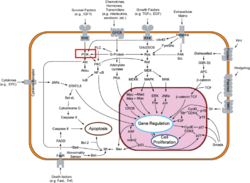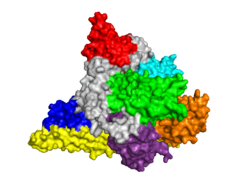| This is a default text for your page Emma Charles/Sandbox 1. Click above on edit this page to modify. Be careful with the < and > signs.
You may include any references to papers as in: the use of JSmol in Proteopedia [1] or to the article describing Jmol [2] to the rescue.
General presentation of Human Tyrosinase related protein 1
Human Tyrosinase related protein 1 (TYRP1) is a Cu2+/Zn2+ metalloenzyme found in Humans. It is expressed in melanocytes where it plays an important role in pigmentation. TYRP1 is also involved in melanoma and albinism. Therefore, it represents an interesting target for therapy [3]. TYRP1 can also be called : 5,6-dihydroxyindole-2-carboxylic acid oxidase (DHICA oxidase); Catalase B or Glycoprotein 75 (gp75).
Synthesis and transport
Human Tyrosinase related protein 1 is encoded by the TYRP1 gene, which is located on the chromosome 9p23. The protein is expressed in melanosomes and on the surface of melanocytes and melanoma cells [4]. TYRP1 protein is synthesized in the nucleus of melanosomes thanks to a signaling sequence. Then, it will be translated by the ribosomesand the protein will be directly produced in the endoplasmic reticulum. Then it will be transported through the Golgi to a specific organelles called melanosomes, where pigments are synthesized [5]. During its maturation, TYRP1 is glycosylated in asparagine in positions 96; 104; 181; 304; 350 and 395. The sorting in the trans-Golgi and transport of the TYRP1 protein to melanosome is dependant of several proteins such as the
|
Function
Phosphoinositide 3-Kinases or phosphatidylinositol 3-kinase (PI3K) are a family of ubiquitously distributed lipid kinases, that play a critical role in the regulation of numerous cellular processes including cellular growth and morphology, programmed cell death, cell motility and adhesion, mitogenesis and glucose uptake. [17] PI3K generates important second messengers by catalyzing the transfer of the γ-phosphate group of ATP to the D3 position of phosphoinositides. [18] The PI3K preferred substrate is Phosphatidylinositol-4,5-bisphosphate (PIP2), which is converted into phosphatidylinositol-3,4,5-triphosphate (PIP3) upon phosphorylation at the cell membrane. The importance of PI3K is evident in knockout mice studies in which those mice with disruptions of critical PI3K components have significant deficiencies in immune and inflammatory response [19] sometimes resulting in embryonic death.[20] Aberrations in PIP3 levels, either through activation of PI3ks or through inactivation of lipid phosphatase PTEN, occur frequently in numerous forms of cancer, making PI3K an exciting new target to treat cancer among other human diseases.[21] For additional details see
The Classes of PI3Ks
 Signal Transduction Pathway. PI3K Highlighted in Red. Click to Expand PI3Ks can be grouped into three distinct classes, Class I-III.
- Class I PI3Ks, the most well understood and thoroughly explored PI3K class, are composed of a 110kDa and a 50-100 kDa . Activation of Class I PI3Ks is controlled by extracellular signaling via receptors with intrinsic tyrosine kinase activity, G protein-linked receptors, or receptors coupled to SRC like protein tyrosine kinases. [22]
- Class II PI3Ks are relatively poorly understood but are 170-210 kDa and have in vitro substrate specificity toward PtdIns 4-P.
- Class III PI3Ks depend on Vps15p protein Ser/Thr kinases, which recruits the phosphatidylinositol kinase to late Golgi Compartments. [18]
Class I Subclasses
PI3Ks are activated by extracellular agonists via the translocation of PI3Ks to the plasma membrane for easy access to lipid substrates. Depending on the adaptor proteins involved in the process, Class I PI3Ks are segregated into two subgroups. Those that associate with p85 will be directed to phosphorylated tyrosine motifs (Class IA), Phosphatidylinositol-4, 5-bisphosphate 3-kinase (PI3Kγ) catalyzes the conversion of 1-phosphatidyl-1D-myo-inositol-4, 5-bisphosphate and ATP to 1-phosphatidyl-1D-myo-inositol-4, 5-trisphosphate. PI3Kγ interacts with trimeric G proteins and the p101 protein (Class IB) [18]
Structure of PI3K
For Full Article, See: The Structure of PI3K
Class I PI3Ks, which are tightly regulated by tyrosine kinases, are composed of an 85kDa regulatory/adapter subunit (p85) and a 110kDa catalytic subunit (p110). [23]
PI3K Activation, Inhibition, and Medical Implications
For Full Article, See: PI3K Activation, Inhibition, & Medical Implications
A number of inhibitors for PI3K have been developed to understand how PI3K is activated and functions. These analysis have massive medical implications for the treatment of Cancer and Diabetes. Inhibitors of Type I PI3K p110γ and Type I PI3K p110δ are tested as therapeutic drugs against inflammatory etiologists [24].
3D Structures of PI3K
Phosphoinositide 3-kinase 3D structures
|
Additional Resources
- See: Cancer For Additional Proteins involved in the disease.
- See: Oncogenes for Additional examples of oncogenes and tumor suppressor genes.
References
- ↑ Hanson, R. M., Prilusky, J., Renjian, Z., Nakane, T. and Sussman, J. L. (2013), JSmol and the Next-Generation Web-Based Representation of 3D Molecular Structure as Applied to Proteopedia. Isr. J. Chem., 53:207-216. doi:http://dx.doi.org/10.1002/ijch.201300024
- ↑ Herraez A. Biomolecules in the computer: Jmol to the rescue. Biochem Mol Biol Educ. 2006 Jul;34(4):255-61. doi: 10.1002/bmb.2006.494034042644. PMID:21638687 doi:10.1002/bmb.2006.494034042644
- ↑ Ghanem G, Fabrice J. Tyrosinase related protein 1 (TYRP1/gp75) in human cutaneous melanoma. Mol Oncol. 2011 Apr;5(2):150-5. doi: 10.1016/j.molonc.2011.01.006. Epub 2011 Feb , 3. PMID:21324755 doi:http://dx.doi.org/10.1016/j.molonc.2011.01.006
- ↑ Ghanem G, Fabrice J. Tyrosinase related protein 1 (TYRP1/gp75) in human cutaneous melanoma. Mol Oncol. 2011 Apr;5(2):150-5. doi: 10.1016/j.molonc.2011.01.006. Epub 2011 Feb , 3. PMID:21324755 doi:http://dx.doi.org/10.1016/j.molonc.2011.01.006
- ↑ Ghanem G, Fabrice J. Tyrosinase related protein 1 (TYRP1/gp75) in human cutaneous melanoma. Mol Oncol. 2011 Apr;5(2):150-5. doi: 10.1016/j.molonc.2011.01.006. Epub 2011 Feb , 3. PMID:21324755 doi:http://dx.doi.org/10.1016/j.molonc.2011.01.006
- ↑ Ghanem G, Fabrice J. Tyrosinase related protein 1 (TYRP1/gp75) in human cutaneous melanoma. Mol Oncol. 2011 Apr;5(2):150-5. doi: 10.1016/j.molonc.2011.01.006. Epub 2011 Feb , 3. PMID:21324755 doi:http://dx.doi.org/10.1016/j.molonc.2011.01.006
- ↑ Ghanem G, Fabrice J. Tyrosinase related protein 1 (TYRP1/gp75) in human cutaneous melanoma. Mol Oncol. 2011 Apr;5(2):150-5. doi: 10.1016/j.molonc.2011.01.006. Epub 2011 Feb , 3. PMID:21324755 doi:http://dx.doi.org/10.1016/j.molonc.2011.01.006
- ↑ Liu TF, Kandala G, Setaluri V. PDZ domain protein GIPC interacts with the cytoplasmic tail of melanosomal membrane protein gp75 (tyrosinase-related protein-1). J Biol Chem. 2001 Sep 21;276(38):35768-77. doi: 10.1074/jbc.M103585200. Epub 2001, Jul 5. PMID:11441007 doi:http://dx.doi.org/10.1074/jbc.M103585200
- ↑ Liu TF, Kandala G, Setaluri V. PDZ domain protein GIPC interacts with the cytoplasmic tail of melanosomal membrane protein gp75 (tyrosinase-related protein-1). J Biol Chem. 2001 Sep 21;276(38):35768-77. doi: 10.1074/jbc.M103585200. Epub 2001, Jul 5. PMID:11441007 doi:http://dx.doi.org/10.1074/jbc.M103585200
- ↑ Ghanem G, Fabrice J. Tyrosinase related protein 1 (TYRP1/gp75) in human cutaneous melanoma. Mol Oncol. 2011 Apr;5(2):150-5. doi: 10.1016/j.molonc.2011.01.006. Epub 2011 Feb , 3. PMID:21324755 doi:http://dx.doi.org/10.1016/j.molonc.2011.01.006
- ↑ Kobayashi T, Urabe K, Winder A, Jimenez-Cervantes C, Imokawa G, Brewington T, Solano F, Garcia-Borron JC, Hearing VJ. Tyrosinase related protein 1 (TRP1) functions as a DHICA oxidase in melanin biosynthesis. EMBO J. 1994 Dec 15;13(24):5818-25. PMID:7813420
- ↑ Liu TF, Kandala G, Setaluri V. PDZ domain protein GIPC interacts with the cytoplasmic tail of melanosomal membrane protein gp75 (tyrosinase-related protein-1). J Biol Chem. 2001 Sep 21;276(38):35768-77. doi: 10.1074/jbc.M103585200. Epub 2001, Jul 5. PMID:11441007 doi:http://dx.doi.org/10.1074/jbc.M103585200
- ↑ doi: https://dx.doi.org/10.1007/s003359900678
- ↑ Vijayasaradhi S, Bouchard B, Houghton AN. The melanoma antigen gp75 is the human homologue of the mouse b (brown) locus gene product. J Exp Med. 1990 Apr 1;171(4):1375-80. doi: 10.1084/jem.171.4.1375. PMID:2324688 doi:http://dx.doi.org/10.1084/jem.171.4.1375
- ↑ Ghanem G, Fabrice J. Tyrosinase related protein 1 (TYRP1/gp75) in human cutaneous melanoma. Mol Oncol. 2011 Apr;5(2):150-5. doi: 10.1016/j.molonc.2011.01.006. Epub 2011 Feb , 3. PMID:21324755 doi:http://dx.doi.org/10.1016/j.molonc.2011.01.006
- ↑ Journe F, Id Boufker H, Van Kempen L, Galibert MD, Wiedig M, Sales F, Theunis A, Nonclercq D, Frau A, Laurent G, Awada A, Ghanem G. TYRP1 mRNA expression in melanoma metastases correlates with clinical outcome. Br J Cancer. 2011 Nov 22;105(11):1726-32. doi: 10.1038/bjc.2011.451. Epub 2011, Nov 1. PMID:22045183 doi:http://dx.doi.org/10.1038/bjc.2011.451
- ↑ Djordjevic S, Driscoll PC. Structural insight into substrate specificity and regulatory mechanisms of phosphoinositide 3-kinases. Trends Biochem Sci. 2002 Aug;27(8):426-32. PMID:12151228
- ↑ 18.0 18.1 18.2 Wymann MP, Pirola L. Structure and function of phosphoinositide 3-kinases. Biochim Biophys Acta. 1998 Dec 8;1436(1-2):127-50. PMID:9838078
- ↑ Sasaki T, Irie-Sasaki J, Horie Y, Bachmaier K, Fata JE, Li M, Suzuki A, Bouchard D, Ho A, Redston M, Gallinger S, Khokha R, Mak TW, Hawkins PT, Stephens L, Scherer SW, Tsao M, Penninger JM. Colorectal carcinomas in mice lacking the catalytic subunit of PI(3)Kgamma. Nature. 2000 Aug 24;406(6798):897-902. PMID:10972292 doi:10.1038/35022585
- ↑ Bi L, Okabe I, Bernard DJ, Wynshaw-Boris A, Nussbaum RL. Proliferative defect and embryonic lethality in mice homozygous for a deletion in the p110alpha subunit of phosphoinositide 3-kinase. J Biol Chem. 1999 Apr 16;274(16):10963-8. PMID:10196176
- ↑ Miled N, Yan Y, Hon WC, Perisic O, Zvelebil M, Inbar Y, Schneidman-Duhovny D, Wolfson HJ, Backer JM, Williams RL. Mechanism of two classes of cancer mutations in the phosphoinositide 3-kinase catalytic subunit. Science. 2007 Jul 13;317(5835):239-42. PMID:17626883 doi:317/5835/239
- ↑ Stephens LR, Hughes KT, Irvine RF. Pathway of phosphatidylinositol(3,4,5)-trisphosphate synthesis in activated neutrophils. Nature. 1991 May 2;351(6321):33-9. PMID:1851250 doi:http://dx.doi.org/10.1038/351033a0
- ↑ Hoedemaeker FJ, Siegal G, Roe SM, Driscoll PC, Abrahams JP. Crystal structure of the C-terminal SH2 domain of the p85alpha regulatory subunit of phosphoinositide 3-kinase: an SH2 domain mimicking its own substrate. J Mol Biol. 1999 Oct 1;292(4):763-70. PMID:10525402 doi:http://dx.doi.org/10.1006/jmbi.1999.3111
- ↑ Harris SJ, Foster JG, Ward SG. PI3K isoforms as drug targets in inflammatory diseases: lessons from pharmacological and genetic strategies. Curr Opin Investig Drugs. 2009 Nov;10(11):1151-62. PMID:19876783
[6], the membrane associated transporter protein (MATP) [7] and the GAIP interacting protein (GIPC) [8]. The final TYRP1 protein is 537 amino-acids long. TYRP1 is transported to the membrane by the biogenesis of lysosome-related organelles complex 1 (BLOC-1) (wikipedia). The amino-terminal domain will be oriented in the lumen of the melanosome, and the carboxy terminal domain in the cytoplasm of the melanocyte [9]. TYRP1 is found only in the membrane of mature stage III and IV melanosomes [10].
Function
Role in melanocytes
First, TYRP1 has a role in melanin biosynthesis. Indeed, this enzyme has a catalytic function in the melanin biosynthetic pathway. When a Cu2+ cation is bound, the protein catalyzes the oxidation of 5,6-dihydroxyindole-2-carboxylic acid (DHICA) into indole-5,6-quinone-2-carboxylic acid. This protein is also able to catalyze the oxidation of 5,6-dihydroxyindole (DHI) into indole-5,6-quinone. Both products will allow to obtain eu-melanin, while pheo-melanin is obtain thanks to TYRP2 activity [11]. The activity of the TYRP1 enzyme increase when the serine residues in position 505 and 509 are phosphorylated [12].
However, the exact role of TYRP1 in pigmentation remains still unclear. Indeed, no gene polymorphism has been observed among caucasian population, despite the variation of hair and skin colors [13].
In addition, the mouse homolog of the TYRP1 is involved in melanocytes differenciation too. Therefore, it could be used as a differentiation marker [14]. In humans, the exact role of TYRP1 in differentiation of melanocyte is unclear. However, it is supposed that the protein is involved in the mechanism, as it is involved in pigmentation.
Role in melanoma
TYRP1 also have a role in progression of melanoma. In fact, as TYRP1 is involved in the proliferation and differentiation of melanocytes, a mutation of the protein is associated with a higher risk for melanoma [15]. Therefore, the level of expression of TYRP1 mRNA is prognostic marker [16].
References
This is a sample scene created with SAT to by Group, and another to make of the protein. You can make your own scenes on SAT starting from scratch or loading and editing one of these sample scenes.
|



